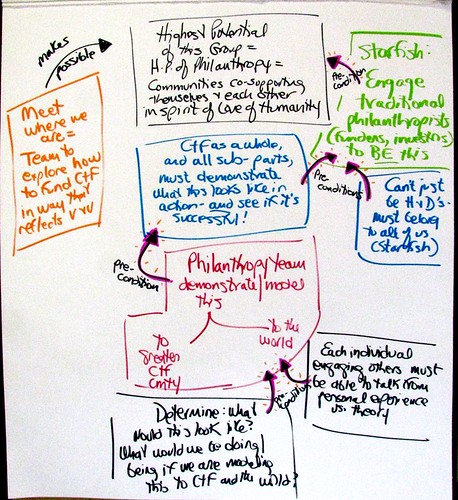 (This is part 2 in the continuing story of Creating the Future’s Philanthropy R&D Lab. For Part 1, click on this link.) If you’ve been following our adventures at Creating the Future, you know that a big part of what makes this work effective is back-casting – reverse engineering the future we want for our world. (And if you’re not familiar with that, this TEDx talk explains both how and why it works). The graphic above shows that process in action, as it depicts some of the conversation from the team’s February meeting. It’s a bit cryptic, I know – but if nothing else, it shows an approach that is all about setting up the dominoes in the chain of cause-and-effect that will encourage our desired result to emerge. The 2 boxes in black ink at the bottom of that graphic were the topic of our February meeting.
(This is part 2 in the continuing story of Creating the Future’s Philanthropy R&D Lab. For Part 1, click on this link.) If you’ve been following our adventures at Creating the Future, you know that a big part of what makes this work effective is back-casting – reverse engineering the future we want for our world. (And if you’re not familiar with that, this TEDx talk explains both how and why it works). The graphic above shows that process in action, as it depicts some of the conversation from the team’s February meeting. It’s a bit cryptic, I know – but if nothing else, it shows an approach that is all about setting up the dominoes in the chain of cause-and-effect that will encourage our desired result to emerge. The 2 boxes in black ink at the bottom of that graphic were the topic of our February meeting.
- How can the Philanthropy Lab demonstrate what co-supporting a community / a cause / a movement looks like?
- If philanthropy is not so much about money, but about all of us together ensuring our communities are whole and healthy, what would it look like if individual team members were modeling this?
- How would each of us as individuals be relating to the Creating the Future community?
- To the world?
It’s one thing to talk in theory and philosophy, or to focus on what others should do. It’s quite another for each of us to be able to say, “Here’s what we did, and here’s what happened as a result. Here’s how our actions changed from focusing on raising money (the norm in the philanthropy world), to instead focus on building true partnerships, where the whole of each partner was honored and brought to its own highest potential.” These are meaty topics, to be certain. They are meaty when we’re just talking in theory. When the mandate is “No theory without practical application” – AND when that practical application means each one of us as individuals must determine what we will actually do – well, the discussion was pretty mind-bending at times. Here is just some of what the group came up with (I say “some” because I won’t pretend I was able to capture it all):
- If we are hoping to see communities that are filled with people who are truly co-supporting themselves and each other, that is about being supportive, rather than something we do (giving money, or me helping your cause).
- We would all be figuring it out together. It’s about the big “us” of “all of us” vs. “us inside this org and you outside”
- We would be gracious in acknowledging our own fears and stigmas about money – the stigmas around those of us who have money, and around those of us who do not. We would be sensitive to and compassionate about the unspoken assumptions and expectations we culturally bring to “money”
- We would be tapping into our own giving, giving of ourselves to this effort, in all ways (including money and all the rest that we are / have)
- We would be honoring the whole of who each of us is inside vs. what each of us has (money)
- We would stop talking about relationships and start BEING Relationships
- If we don’t want to see siloing, we won’t compartmentalize ourselves
- “When I give freely to something I believe in, I feel gratitude because it is there. Since giving to Creating the Future, I feel grateful. I feel more connected – with my being, my spirit.” Sharing THAT.
- We would be listening. I want to hear where folks are – what they’re interested in.
- We would be sharing mutual enjoyment in sharing ideas.
As we do at the end of every meeting, we asked ourselves what had stood out – some time for reflection before heading back into the world. And the overwhelming sentiment was the repeated question: In making this practical for our colleagues, what does that mean for each of us to be and do? What will it look like for each of us to model what it means in action (not in theory) to co-support an effort, a program, a movement – a community? As we prepared for the March meeting, we summarized what had transpired, and set the stage for what’s next. You’ll find that in the video below. (Note: the document referenced in this video as “in the Google doc” is here.) The story continues to unfold. And you can write yourself into that story starting right here! (That means adding your comments!!!)
